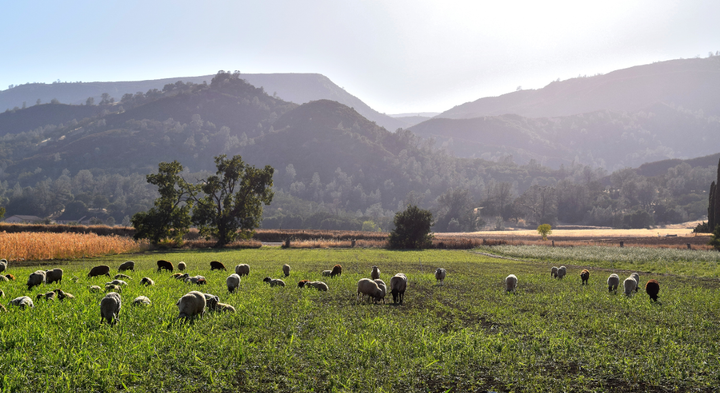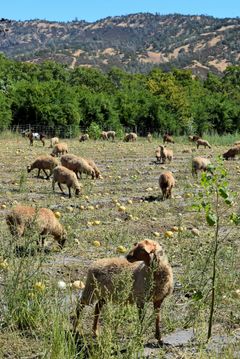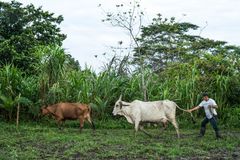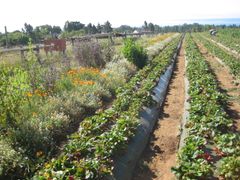"Drop industrial agriculture": Major study reports that people and environment both benefit from diversified farming, while bottom lines also thrive
Mixing livestock and crops, integrating flower strips and trees, water and soil conservation and much more: Massive new global study led by the University of Copenhagen and University of Hohenheim, has examined the effects of diversified agriculture. The conclusion is abundantly clear – positive effects increase with every measure, while negative effects are hard to find.

Laura Vang Rasmussen of the University of Copenhagen can finally wipe the sweat from her brow. For the last four years, she has served as the link between 58 researchers on five continents and as lead author of a major agricultural study which gathered data from 24 research projects, along with colleague Ingo Grass of the University of Hohenheim in Germany.
The hard work has finally paid off. Their research article, just published in the prestigious journal SCIENCE, delivers a clear and well-founded message to agriculture:
"Drop monoculture and industrial thinking and diversify the way you farm – it pays off," as Laura Vang Rasmussen from the Department of Geosciences and Natural Resource Management puts it.
"Our results from this comprehensive study are surprisingly clear. While we see very few negative effects from agricultural diversification, there are many significant benefits. This is particularly the case when two, three or more measures are combined. The more, the better, especially when it comes to biodiversity and food security," she explains.
The researchers see the greatest positive effects on food security, followed closely by biodiversity. Furthermore, social outcomes in the form of well-being also improved significantly.
Among the many strategies adopted, livestock diversification and soil conservation had the most positive outcomes.
Yields not hampered– with clearly improved food security
According to the researcher, previous studies investigated either the socioeconomic or environmental effects of agricultural diversification. This study investigates effects across the board, with surprisingly positive results.
"Agricultural diversification has been accused of perhaps being good for biodiversity, but having a few negative aspects too – especially with regards to not being able to achieve sufficiently high yields. But what we actually see, is that there is no reduction in yield from diversified agriculture – not even when we include data from large-scale European agriculture," says Ingo Grass of the University of Hohenheim.
In fact, the figures demonstrate that in the case of small farms and farms with lots of cultivated land in the surroundings, more diversified agriculture can significantly promote food security. This, according to the researchers, could be due to a number of factors.
"One example is fruit trees planted in maize fields in Malawi, which can help farming families improve their food security through improved diet and nutrition. Partly because they eat the fruits themselves, and also because the trees generate extra income when their fruits are sold at market – income that provides small-scale farmers with purchasing power for other foods," says Laura Vang Rasmussen.
Massive amount of data revealed win-win outcomes
All 58 of the study’s authors participated actively in its design to attempt a robust and credible interweaving of the many data sets spread across the world – from maize production in Malawi, to rubber trees in Indonesia, to silvopastoral cattle farming in Colombia and winter wheat in Germany.
"The study unites many different situations from the many data sets that we used. In Malawi, we have data on food security expressed, for example, in the number of hungry months for small-scale farmers where they have been short of food. Such metrics are not used for, for example, large European farms, where we have yield data instead, such as winter-wheat yields in Germany, explains Rasmussen, who continues:
"But the point is that when we look across all datasets, our results show that applying more diversification strategies improved both biodiversity and food security, and didn’t have a negative effect on yields."
The researchers also investigated which diversification strategies result in 'pairs' of favorable “win-win” outcomes. Their data showed that strategies beneficial for biodiversity also improved food security.
They also witnessed win-wins for biodiversity and people's well-being.
Effects with and without natural areas in surroundings
To investigate whether the surrounding landscape influences the effects of diversification strategies, the study also took three different types of landscapes into account: heavily cultivated areas with very little nature, an in-between “simple” category with mixed landscapes, and areas where the landscape around farms is characterized by nature that is relatively pristine.
Until now, the thesis has been that diversified agriculture would only have a very good effect on biodiversity for in-between or “simple” type landscapes, which is also where the researchers recorded the greatest effects. But in fact, the study shows that diversification strategies make good sense in many different contexts. Even in landscapes with more nature, there are positive effects to be gained with regards to biodiversity.
"It's a simple message to be able to pass on to different types of farms – whether it is small farms in South America or Africa or advanced European agriculture, there are lots of positive effects to be gained by introducing these various strategies – and very little to fear. It is very positive that so many different things can be addressed, and that, in general, positive biodiversity outcomes seem to go hand in hand with well-being and food security," says the Ingo Grass.
This is backed by Professor Zia Mehrabi from the University of Colorado Boulder and Professor Claire Kremen of the University of British Columbia who are the joint PI’s of the study:
“This is an important achievement in bringing together some of the world’s foremost agricultural researchers to synthesise the data needed to back policy on driving the transformations that are needed in farming landscapes,” says Professor Zia Mehrabi. He is joined by Professor Claire Kremen of the University of British Columbia:
“The study shines a light on real-world farming conditions in many different regions and contexts worldwide. With the clear positive outcomes of these diversification strategies it suggests that governments and businesses should invest more in incentivizing farmers to adopt such strategies, which will in fact help them while also promoting agricultural sustainability and planetary health,” she says.
*
Extra info: Unique study design involved researchers worldwide.
With 58 researchers scattered around the globe, all of whom have been involved in the design of the study and the interweaving of their 24 datasets from other studies – representing a total of 2655 farms on five continents – the research project is quite unique.
"As far as I know, this has never been done on such a scale before. Finding common indicators for these calculations, in so many different studies and diverse data, and in such a way that we were able to integrate them, has been hard work. But I think the approach may inspire future research. That the enormous amount of data we processed provides such clear results is quite groundbreaking," says Laura Vang Rasmussen.
Extra info: Few negative effects may be temporary
The study found very few measurable negative effects resulting from diversification efforts. One of them was in connection with the category "non-crop-diversification", e.g. planting of trees on farms. Data show that these activities can affect farms specifically with regards to well-being – or quality of life, but this may be a transitional period.
"We cannot say with certainty what is driving this, but it may be due to the increased labour required to plant and maintain trees on farmland. This could manifest itself as a negative effect on well-being. One explanation could be that it takes time to reap the rewards of having trees on farms. So, whereas planting trees takes an immediate toll on the labour requirements, it takes years before the fruits of the trees can be harvested," says Laura Vang Rasmussen.
Facts: Three types of surrounding landscapes
The study investigated whether the degree of natural habitat in the surrounding landscape moderates the effects of diversification:
Cleared Landscapes: <5% semi-natural habitat in a given landscape
Simple Landscapes: 5-20% semi-natural habitat in a given landscape
Complex Landscapes: >20% semi-natural habitat in a given landscape
Facts: Agricultural diversification: Strategies and practices
The research article has collected data on the effects of more than 20 different types of diversification practices within five broad categories of diversification.
| Temporal crop diversification |
Rotation |
| Non-crop diversification | Hedgerows Windbreaks Flower strips Beetle banks Forage strips Other non-crop diversity |
|
Soil conservation |
Manure application Compost application Green manure application Inoculant application Biochar application Residue incorporation Mulching Nutrient mobilizing plants Other beneficial soil amendment practices |
| Livestock diversification | Number of livestock species, including e.g., cattle, horses, pigs, goats, sheep, fowls, donkeys, fish, and managed bees |
| Water conservation |
Terracing Continuity of cover/roots |
Behind the research:
Laura Vang Rasmussen from the University of Copenhagen and Ingo Grass from the University of Hohenheim, Germany, are joint first authors of the study.
Professor Zia Mehrabi, at the University of Colorado Boulder and Professor Claire Kremen of the University of British Columbia are joint PI’s of the study. They helped bring together the international research team at the NSF funded National Socio-Environmental Synthesis Center, in the United States.
See the rest of the extensive author list in the study: https://www.science.org/doi/10.1126/science.adj1914
Keywords
Contacts
Laura Vang RasmussenAssociate professorDepartment of Geosciences and Natural Resource Management, University of Copenhagen
Tel:+45 35 32 58 60lr@ign.ku.dkIngo GrassProf. Dr.Department of Ecology of Tropical Agricultural Systems, University of Hohenheim
Tel:+49 711 459 22385ingo.grass@uni-hohenheim.deKristian Bjørn-HansenJournalist and Press ContactFaculty of Science, Copenhagen University
Tel:+45 93516002kbh@science.ku.dkImages



Links
ABOUT THE FACULTY OF SCIENCE
The Faculty of Science at the University of Copenhagen – or SCIENCE – is Denmark's largest science research and education institution.
The Faculty's most important task is to contribute to solving the major challenges facing the rapidly changing world with increased pressure on, among other things, natural resources and significant climate change, both nationally and globally.
Subscribe to releases from Københavns Universitet - Det Natur- og Biovidenskabelige Fakultet
Subscribe to all the latest releases from Københavns Universitet - Det Natur- og Biovidenskabelige Fakultet by registering your e-mail address below. You can unsubscribe at any time.
Latest releases from Københavns Universitet - Det Natur- og Biovidenskabelige Fakultet
Nyt studie peger på Skagerrak som et slags ”fritidshjem” for den gådefulde grønlandshaj9.7.2025 09:00:00 CEST | Pressemeddelelse
Grønlandshajen – verdens længstlevende hvirveldyr – forbindes oftest med kolde arktiske vande. Et nyt internationalt studie ledt af forskere fra Grønlands Naturinstitut og Københavns Universitet viser dog, at Skagerrak sandsynligvis fungerer som opvækstområde for unge grønlandshajer. Studiet peger også på at grønlandshajer slet ikke fødes i hverken Grønland eller andre steder i Arktis.
Old aerial photos give scientists a new tool to predict sea level rise3.7.2025 08:00:00 CEST | Press release
Researchers from the University of Copenhagen have gained unique insight into the mechanisms behind the collapse of Antarctic ice shelves, which are crucial for sea level rise in the Northern Hemisphere. The discovery of old aerial photos has provided an unparalleled dataset that can improve predictions of sea level rise and how we should prioritise coastal protection and other forms of climate adaptation.
Gamle luftfotos giver forskere nyt redskab til at forudsige havstigninger3.7.2025 08:00:00 CEST | Pressemeddelelse
Forskere fra Københavns Universitet har fået unik adgang til at forstå mekanismerne bag antarktiske ishylders kollaps, som er afgørende for havstigninger på den nordlige halvkugle. Et fund af gamle luftfotos har skabt et enestående datasæt, som kan forbedre vores forudsigelser af hvor meget havene stiger, og vores prioritering af kystsikring og andre klimatilpasninger.
Ny institutleder på IFRO: ”Faglighed og fællesskab går hånd i hånd”1.7.2025 10:49:17 CEST | Pressemeddelelse
Per Svejstrup er fra 1. august ansat som institutleder på Institut for Fødevare- og Ressourceøkonomi (IFRO). Den kommende leder træder ind i rollen med stor respekt for IFRO's faglige og kollegiale kultur med klare ambitioner for fremtiden.
Dangerous Variant of Salmonella Still Not Eradicated – Researchers Point to the Solutions1.7.2025 09:53:23 CEST | Press release
The infectious and multi-resistant cattle disease Salmonella Dublin can be fatal to both humans and animals and causes significant losses for farmers. Although Denmark has attempted to eradicate the disease since 2008, it has not yet succeeded. A study from the University of Copenhagen points to possible reasons – and the necessary solutions.
In our pressroom you can read all our latest releases, find our press contacts, images, documents and other relevant information about us.
Visit our pressroom